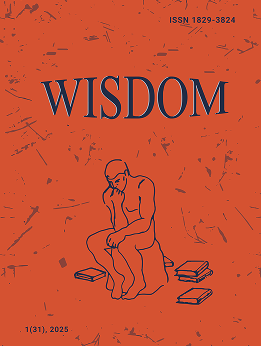The “Yin” and “Yang” Ancient Chinese Philosophy and its Practical Application to Body Treatment
DOI:
https://doi.org/10.24234/wisdom.v24i4.948Keywords:
dialectical relationship, yin and yang theory, human bodyAbstract
The birth of the theory of yin and yang is the result of a long process of reflecting and generalizing the practice of the Chinese people in ancient times. The original meaning of the theory of yin and yang was only an expression of the contrast between light and darkness. Its development has become a theory to explain the laws of nature, society and thought. In this article we will focus on clarifying the relationship of yin and yang theory on the human body through the relationships of the above, below, left and right, inside and outside, diagonal in the body position. To have a solid basis for this determination, we have conducted an evaluation at a health clinic from June 2005 to September 2022 with 2,402 people. The determination of the yin-yang relationship on the human body is conducted and recorded in a scientific and objective manner.
Downloads
References
Bhadra, N. K. (2019). A human is a miniature of universe. IOSR Journal of Biotechnology and Biochemistry, 5, 56-73. doi: 10.9790/264X-0505015673
Chen, G.-M. (2008). Bian (Change): A perpetual discourse of I Ching. Intercultural Communication Studies, 17(4), 7-16.
Chen, M.-J. (2002). Transcending paradox: The Chinese ëmiddle wayí perspective. Asian Pacific Journal of Management, 19(2/3), 179-199. doi: 10.1023/A:1016235517735 DOI: https://doi.org/10.1023/A:1016235517735
Chen, M.-J. (2008). Reconceptualizing the competition-cooperation relationship: A transparadox perspective. Journal of Management Inquiry, 17(4), 288-304. DOI: https://doi.org/10.1177/1056492607312577
Chuang Tzu (2008). Basic writings. Hanoi: Culture Publishing House.
Cooper, J. C. (1990). Taoism: The way of the mystic. Wellingborough, UK: Aquarian Press.
Fang, T. (2003). A critique of Hofstedeís fifth national culture dimension. International Journal of Cross Cultural Management, 3(3), 347-368. DOI: https://doi.org/10.1177/1470595803003003006
Fang, T. (2012). Yin Yang: A new perspective on culture. Management and Organization Review, 8(01), 25-50. doi: 10.1111/j.1740-8784.2011.00221.x DOI: https://doi.org/10.1111/j.1740-8784.2011.00221.x
Fletcher, R., & Fang, T. (2006). Assessing the impact of culture on relationship creation and network formation in emerging Asian markets. European Journal of Marketing, 40, 430-446. DOI: https://doi.org/10.1108/03090560610648138
Fung, Y.-L. e. B. D. B. (1948). A short history of Chinese philosophy. New York: MacMillan.
Fung, Y. L. (1952). A history of Chinese philosophy, Vol. 1. Translated and edited by Derk Bodde. Princeton: Princeton University Press.
Unschuld, P., & Tessenow, H. (2011). Huang Di Nei Jing Su Wen (1st ed.). University of California Press. Retrieved November 7, 2022 from https://www.perlego.com/book/551348/huang-di-nei-jing-su-wen-pdf DOI: https://doi.org/10.1525/9780520948181
Lawrence, P., & Lorsch, J. (1967). Differentiation and integration in complex organizations. Administrative Science Quarterly, 12(1), 1-30. DOI: https://doi.org/10.2307/2391211
Lee, Y.-T. (2000). What is missing in Chinese-Western dialectical reasoning? American Psychologist, 55(9), 1065-1067. DOI: https://doi.org/10.1037/0003-066X.55.9.1065
Lee, Y.-T., Han, A.-G., Byron, T. K., & Fan, H.-X. (2008). Daoist Leadership: Theory and application. In C.-C. Chen, & Y.-T. Lee (Eds.), Leadership and management in China: Philosophies, theories and practices (pp. 83-107). New York: Cambridge University Press. DOI: https://doi.org/10.1017/CBO9780511753763.005
Li, P. P. (1998). Towards a geocentric framework of organizational form: A holistic, dynamic and paradoxical approach. Organization Studies, 19(5), 829-861. DOI: https://doi.org/10.1177/017084069801900506
Li, P. P. (2008). Toward a geocentric framework of trust: An application to organizational trust. Management and Organization Review, 4(3), 413-439. https://doi.org/10.1111/j.1740-8784.2008.00120.x DOI: https://doi.org/10.1111/j.1740-8784.2008.00120.x
Li, P. P. (2011). The rigour-relevance balance for engaged scholarship: New frame and new agenda for trust research and beyond. Journal of Trust Research, 1(1), 1-21. DOI: https://doi.org/10.1080/21515581.2011.550718
Peng, K., & Nisbett, R. E. (1999). Culture, dialectics, and reasoning about contradiction. American Psychologist, 54(9), 741-754. DOI: https://doi.org/10.1037/0003-066X.54.9.741
The Su Wen of the Huangdi Neijing (Inner classic of the yellow emperor) (n.d.). In Library of Congress. Retrieved November 10, 2022, from https://hdl.loc.gov/loc.wdl/wdl.3044
Vo, V. D. (2020). The theory of yin and yang and its significance for modern medicine. Hue University Publisher.
Wang, R. R. (2013). Understanding of yin yang. Religion Compass, 7(6), 214-224. DOI: https://doi.org/10.1111/rec3.12047
Xinyan Xinyan (2013). Chinese dialectical thinking - the Yin Yang model. Philosophy Compass, 8(5), 438-446. https://doi.org/10.1111/phc3.12035 DOI: https://doi.org/10.1111/phc3.12035
Xu, Y. (2002). The annotation and explication of discussions of the states (rev. ed.). (Compilation). Beijing: Zhonghua Book Company.
Downloads
Published
How to Cite
Issue
Section
License
Copyright (c) 2022 Dung VAN VO; Long XUAN CAO

This work is licensed under a Creative Commons Attribution-NonCommercial 4.0 International License.
Creative Commons Attribution-Non-Commercial (CC BY-NC). CC BY-NC allows users to copy and distribute the article, provided this is not done for commercial purposes. The users may adapt – remix, transform, and build upon the material giving appropriate credit, and providing a link to the license. The full details of the license are available at https://creativecommons.org/licenses/by-nc/4.0/.















